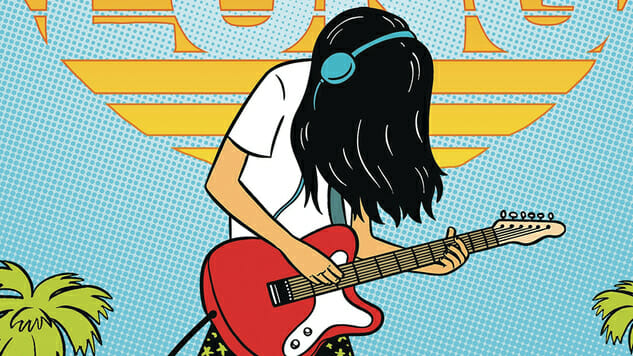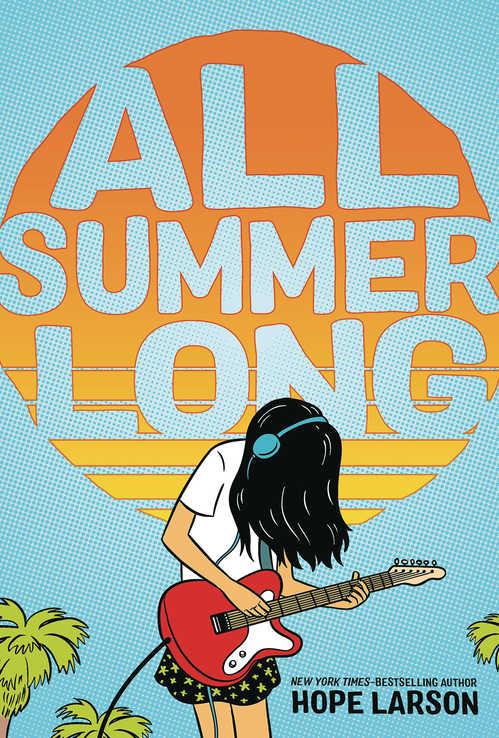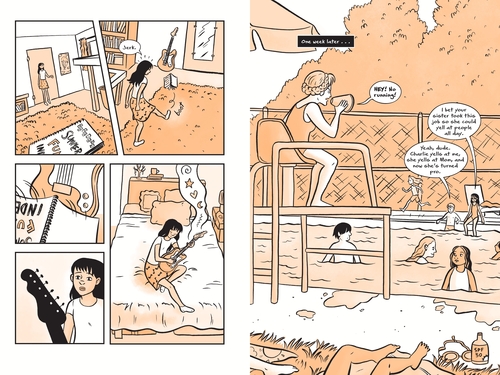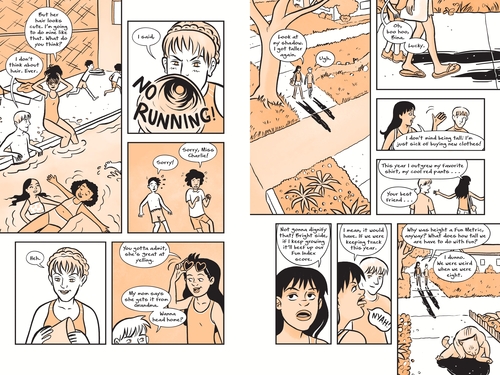All Summer Long’s Hope Larson Talks Music, Inclusiveness & Being a “Big Dork” as a Teenager
Art by Hope Larson Comics Features Hope Larson
Over the past 10 years, Hope Larson has shifted a bit from being primarily known as an artist to being better known as a writer, but she’s great at both things, and her new book All Summer Long lets her show it. It’s more disciplined than her early work in some ways—or maybe it would be fairer to call it less lyrical—but it has the same gently probing interest in adolescence that is present throughout her career. There’s nothing very dreamy in All Summer Long, her latest preteen-friendly release from publisher Farrar, Straus and Giraux, and that makes it a stronger book. For those unfamiliar, All Summer Long finds protagonist Bina discovering music just as her relationship with longtime friend Austin starts to drift in the wake of puberty and the countless changes that come with turning 13. The lessons in it are subtle (but there!), and the characters feel real. Larson chatted with us over email about the book, the role of music in her life and what made her change paths from drawing to writing.
![]()

All Summer Long Cover Art by Hope Larson
Paste: You go back and forth among writing for other people to draw, drawing other people’s writing and writing and drawing your own stuff. Are there adjustments you have to make when switching from one of those to another, or is it an easy transition?
Hope Larson: Aside from A Wrinkle in Time, which I also scripted, I don’t draw for other people. But, for the most part, it’s an easy transition. I write full script no matter who I’m writing for, meaning that I write out what’s in every panel, on every page, in advance. The main difference from project to project is that if an artist is particularly good at drawing something (environments, hand-to-hand combat, gooshy feelings), I try to play to their strengths.
Paste: Which do you like the most?
Larson: I prefer to write for a trusted collaborator with whom I’ve established a rapport. Drawing myself isn’t something I particularly enjoy, but I do find that process gratifying.
Paste: Did you start out more as a writer or more as an artist? How did your schooling affect where you went from there?
Larson: I was definitely more on the art side starting out. I went to art school. I didn’t study writing or storytelling. I didn’t become confident as a writer until I had good editors to help me through the process; now it’s my favorite part of making a comic.
Paste: So what led you more into writing than drawing? What was the tipping point, basically?
Larson: I burned myself out a bit drawing A Wrinkle in Time, which is 400 pages long, and wanted to switch gears. But ultimately, I enjoy the writing part much more than the drawing part of the process.
Paste: What did you think of the movie version of A Wrinkle in Time?
Larson: I think the team made a lot of smart choices that haven’t been appreciated. It’s a challenging book to adapt and compress, which is why I didn’t compress it at all. If I had to crunch it down to movie length, I have no idea how I’d approach it. I don’t know that I could do any better.
Paste: One of the things I see as recurring in your work is this determination not to take a narrative where most people would (i.e., the idea that Bina and Austin would end up together is made to seem ridiculous). Is that intentional?
Larson: No, it’s not. I’m one of those people who feels that there’s nothing new under the sun, and all the stories have been told, and all you can do is write honestly, in the hopes that it will feel new and resonate with readers. I’m definitely not trying to gotcha anyone. I just do my best to understand the characters and write them making the choices that feel true to them.

All Summer Long Interior Art by Hope Larson & MJ Robinson
Paste: Your heart seems to be with two-color work. Is that accurate? Why or why not?
Larson: It’s a nice compromise between black and white and full color. Cheaper and faster to execute than color; less spare than full color. The coloring in this book was done by MJ Robinson, who did a great job.
Paste: One of my favorite details in this book is the visual depiction of the sound of a key unlocking a door, which appears several times. Why is that in the book?
Larson: It’s visual shorthand. Drawing small actions like that can be fiddly and time-consuming, and you don’t gain anything by using two panels to show a key turning in a lock.
Paste: Music seems like an important thing to you (I’m thinking of the playlist that accompanied Solo, for example). How much music do you listen to? Do you play any instruments?
Larson: I listen to music all the time, all day long. It helps me get into the right mood for whatever scene I’m writing, or to stay in the zone. I like writing about music because it’s a good way to write about creativity without writing about, say, a character who’s a writer or artist. Music is cool and collaborative and performative, so it offers lots of scenarios to write about that don’t feature a character alone in their room—although there’s some of that, too.
Paste: What are you listening to lately? Have you done the 10 albums thing that’s been going around Facebook?
Larson: I haven’t been using Facebook much lately, so I haven’t seen that meme. Three albums I love right now are the new Alvvays album, the new Waxahatchee albu, and the new Cherry Glazerr album.
Paste: Paste: Do you listen to music while you draw (or ink)? What kinds?
Larson: I listen to music all the time. A band I’ve been listening to a lot on book tour, which is where I am right now, is Widowspeak. Most of my favorite bands fall into that dream-pop space.

All Summer Long Interior Art by Hope Larson & MJ Robinson
Paste: What were you like as a teenager? What’s the first concert you ever went to?
Larson: I was a big dork as a teenager, and I was an art kid. I had a stretch with pink hair. I’d go see all the independent movies that came to town, alone. I wore horrible 1970s thrift-store dresses. I desperately wanted to be cool, but I was definitely not in the ballpark.
The first concerts I remember seeking out as a teenager were Guster and the Old 97s.
Paste: What’s it like not to be referred to as a “new talent” anymore? Freeing, I would assume?
Larson: I haven’t been “new” in a long time. It’s nice not having to fight to be seen as a legitimate creator. It’s weird to be seen as old and out of touch by the young kids coming up through the ranks.
Paste: What’s it like, living on the West Coast, especially as a native southerner? Do you even consider yourself a southerner? I guess it’s not like you’ve spent your whole life in the South.
Larson: I don’t live on the west coast anymore, and I haven’t for a year. I loved it, but it was too expensive to work for me long-term. I currently live in Asheville, North Carolina. I guess I consider myself more a southerner than anything else; I was born in North Carolina and spent my childhood and teens there. My parents aren’t from there, though, so a lot of people wouldn’t consider me a “real” southerner. As an adult, I’ve lived all over the country, and in Canada. I would probably just say I’m from Asheville.
Paste: Your work has a wonderful inclusiveness to it, not only in terms of race and ethnicity but also sexuality and body types. Is that something that comes naturally to you or do you have to work at it? How do you make yourself get outside of your comfort zone?
Larson: Thank you. Some of those choices were mine (as in All Summer Long, where I wore all the hats except the colorist hat), and some were choices made in tandem with an artist (many/most of the character design choices in Compass South/Knife’s Edge and Goldie Vance). One of the reasons I love working with other artists, especially artists who identify differently than I do, is that they may see the characters differently than I did, and it generally enriches the work if they have freedom of interpretation. In All Summer Long, I wanted to capture some of the diversity of Los Angeles, and the people I know there. If there wasn’t a range of different types of people in the book, it wouldn’t be Los Angeles at all.
